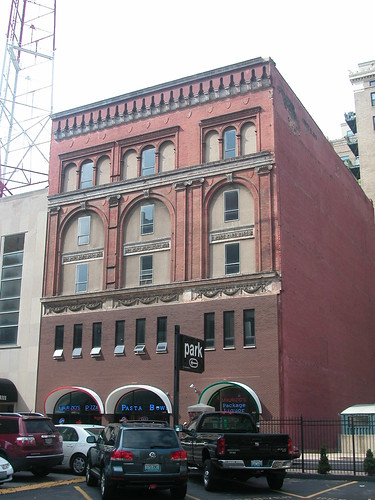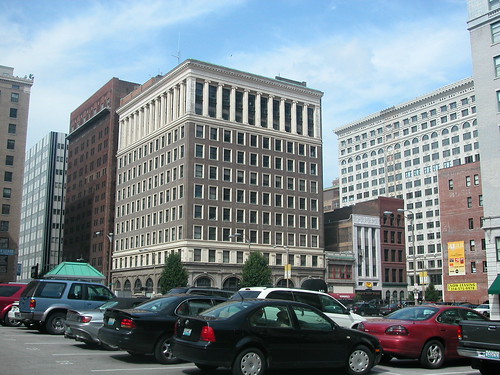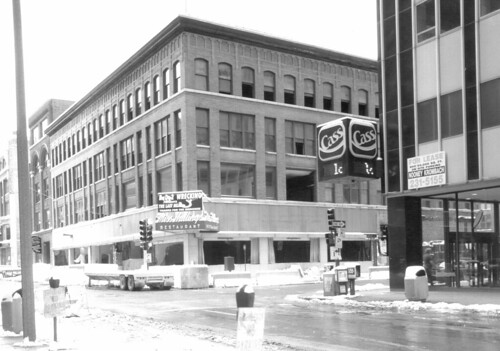by Michael R. Allen

With demolition threatening the building at 1107-09 Olive Street, a look back at the history of the building shows that the building is part of the important “Music Row†cultural district on Olive Street between 10th and Tucker. Today, the narrow buildings on these two blocks that conform to the traditional city lot size share space with larger buildings like the Laclede Gas Building (1911, Mauran Russell & Crowell) and the former St. Louis Post-Dispatch Printing Plant at 1111 Olive Street (1942, Russell, Mullgardt, Schwarz & Van Hoefen). Historically, the encroachment of these big buildings has threatened the little ones, but today the supposed parking needs of the Laclede Gas Building, owned by storied downtown real estate developer Larry Deutsch, is the threat.

The building at 1107-9 Olive Street actually is a fragment of a row of six-story commercial buildings that extended east to Tenth Street and west beyond the current footprint. The eastern section, clad in metal siding for many years, was wrecked in 1998. Part of this row may date back to 1881. The St. Louis Presbytery and the Western Methodist Book Concern had offices in the row throughout the 1880s. By the mid-1880s, the building at 1107 Olive Street was home to the Flower Mission, a poetically-named organization that delivered flowers to convalescents in the city’s hospitals. Various dry goods and furniture dealers are found at addresses in the row through the 1890s. The once-coherent Classical revival façade that covered the group likely corresponds to a 1901 building permit for alterations taken out following a major fire. (The modernist cladding of the two lower floors dates to the 1960s and is reversible.

By the time that the buildings received the new façade, this part of Olive Street was the center of the city’s home piano and sheet music sales district – Music Row. Among the cultural traditions that German-Americans brought to St. Louis was the emphasis on music in the home, for entertainment and enlightenment of young people who were expected to learn piano and other instruments. By 1881 there already was a concentration of the stores that cropped up to serve households seeking pianos and sheet music. Olive Street had four of the city’s twelve piano dealerships in the blocks between 10th and 12th (later Tucker) streets. In 1893, there were seven of the city’s eighteen dealerships. The number held steady for nearly four decades.
In 1909, the Cincinnati-based Rudolph Wurlitzer Company opened its first showroom in St. Louis at 912 Pine Street. On November 5, 1911, the St. Louis Post-Dispatch carried the headline “Outside Firms Least St. Louis Business Sites†and reported on transactions including the Wurlitzer Company’s move to 1109 Olive Street. The article states that the company signed a ten-year lease and that “will be remodeled and altered at a cost of $10,000 to conform with the requirements of the lessee, which will be equipped to compete with the largest and most complete piano emporiums in the city.” Next door was the Baldwin Piano Company.

Yet the not-even-completed Laclede Gas Company Building was noted as a threat even then. The article’s writer predicted that 11th and Olive would “pulsate with new life, constituting a center of prime importance†and speculated that new large buildings might arrive. Some of that forecast rang true, when in 1917 the newspaper itself completed its large new headquarters at 1139 Olive Street (Barnett, Haynes & Barnett). Eventually the newspaper’s operation would lead to demolition of part of the row in which the Wurlitzer Company was locating in 1911.

The advent of recorded music had an impact on Music Row. By 1914, the Story & Clark Piano Company at 1107 Olive Street attracted some attention by adding Edison diamond disc phonographs to its inventory. The ease of recorded music supplanted the need for pianos in middle class households, and by the 1930s Music Row’s businesses were largely gone.

Today, there are 15 buildings left on the Music Row blocks. Of these, three are listed in the National Register of Historic Places for associations with household piano culture: the Balmer and Weber Music Company Building at 1004 Olive Street (1905, H.W. Kirchner with 1928 alterations by Maritz & Young), the Thiebe-Stierlin Music Company Building at 1006 Olive Street (1905, Theodore C. Link) and the Kieselhorst Piano Company Building at 1009 Olive Street (1890). Three others, including the building at 1107-9 Olive Street, have the same associations. The building that once housed Wurlitzer may be singularly eligible for the National Register of Historic Places, but as part of a disrupted row integrity is uncertain. Yet the possibility exists, as does the listing of the building as part of a historic district on the two blocks of Olive between 10th and Tucker. Aside from National Register of Historic Places status – which is not the main point that will be before the Preservation Board –the building tells the story of a cultural moment in the city’s history and of the era of small-scale downtown commercial buildings. So many of the small buildings downtown are lost, and those that remain add a diversity to the streetscapes that ensures that downtown includes parts of its story that started before the modern office building arrived.
MORE
Read Vanishing STL‘s take on the demolition here.
Preliminary review of the demolition appears on the preliminary agenda of the Preservation Board’s November 26 meeting. Cultural Resources Office Director Betsy Bradley has not yet released her recommendation to the Preservation Board. If you have an opinion, let her know: BradleyB@stlouis-mo.gov.

2 replies on “Part of Music Row Threatened”
The loss of buildings in downtown St. Louis is almost criminal. If they can’t even do anything with the vacant land they already have, why more?
I was at the Preservation Board meeting last night and I think this
prelim request was the longest in board history (1.5 hours long). While
is is shame to tear down an existing structure for a parking lot, the
building is in dire need of foundation repair. When a construction co.
built the parking garage next door, they cut away some of footings which
caused damage to the structure of the building in question. In fact,
the owner (who has not paid any taxes on that building for 6-7 years)
sued the construction company and won a $1.2 Million lawsuit. He took
off with the money (and his restaurant) to a different location and sold
the building for $160,000 (and of course all the back taxes). So the
new owner wants to tear down the building citing it is structurally
unsafe and build a parking lot for the future tenants of his new loft
project (Laclede Gas Building Lofts). I don’t know if the structure
itself is historically significant (although Music Row is), but it is better than another
parking lot. On the other hand, there were architects there last night
who testified that the building was not sound in structure so who will
pay for the repairs and who will then occupy the building? If the
building is to remain, there needs to be someone to buy it, correct the
current problems (an estimated $1.2 million worth), and then get tenants
in there or resell the place to at least match their investment. I hope
there are people smarter than I to figure this out. I do think that there needs to be some solution for current residents and employees who work in the city. My wife works downtown (I in South City) and I would not want her walking 4-5 blocks to a parking lot from her work if she stays late at the office.